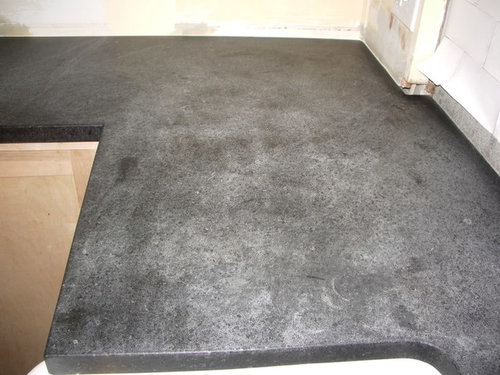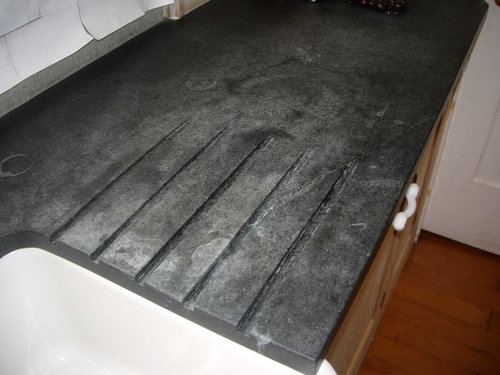Here are a few images of soapstone with a patina , a “not so” perfect feel. If you want your soapstone to have more patina , just don’t oil (mineral oil) it as often. I have soapstone in my kitchen and chose it because of “ patina ”, but then I found myself oiling my counters every time I had company over. It is ideal for classic kitchen styles.
Without treatment, soapstone will darken in uneven regions around surface areas most frequently used. Leaving the soapstone untreated will develop a patina of age that many people enjoy. A weathered or aged appearance occurs naturally over time as the patina is enhanced. Primarily composed of magnesite and talc, soapstone has a high resistance to heat and staining.
Soapstone (also known as steatite or soaprock) is a talc-schist,. The soft feel of soapstone comes from the abundance of mineral talc leading to an almost soap-like feel to it, hence the name. Do I want a “harder” soapstone , or a “softer”? The difference really is, are you looking forward to “ patina ”? If so, the softer soapstone , it is! They both will accumulate patina , over-time.
If you change your min you can go back to oiling the stone. Experts recommend that you clean your soapstone with a mild soap and water. For the right owner, these countertops will be easier to care for and more charming than most other natural stone or engineered stone countertops. The primary care that soapstone requires is a periodic oiling that keeps it looking its best and produces a natural patina as the years go by. In other words, it is done for aesthetic rather than performance reasons.
The only maintenance recommende not require is the mineral oil treatment to enhance the natural darkening process the stone goes through and to ensure the soapstone darkens evenly. Many people seem to love a soapstone counter and love the characteristic patina it develops with use. The beauty of soapstone lends itself well with the natural patina achieved over time. Slight scratches tend to disappear with mineral oil. Deeper scratches can be sanded.
If you do not like a natural patina , soapstone is probably not for you. It will develop it’s own unique patina based on you and your lifestyle. As talc in soapstone is soft to the touch, it gives the smooth feeling of rubbing a piece of dry soap. After applying the wax or oil. Because soapstone consists of talc, the countertop surface is softer to the touch than most natural stone countertop materials.
But it’s not for everyone. I find these photos rather sobering,” laments another commenter after viewing images of the patina that soapstone can acquire. Where does soapstone come from? Beneficial Features: The material is stain-, chemical-, and water-resistant but scratches easily.
Over time, natural soapstone develops a natural patina. Care Instructions: Clean with water. Colors range from dark gray to bluish or.
We even offer stone “ice cubes” for the discerning drinker that prefers no dilution. Some treat soapstone with a food grade mineral oil to retain its luster and mask small scratches that are often common because of its talc content. Others choose not to treat the surface and allow the stone to take on its own unique patina over. The natural “ patina ” of soapstone is evident. How much does soapstone cost?
The price of soapstone is comparable to other natural stones on the market. The cost of your soapstone counter tops may vary depending on soapstone color, project location and other particularities of your. Untreated soapstone develops a patina with age, which lends it a warmer look. A metamorphic rock, soapstone contains numerous minerals which determine its variations in hue, and colouration. What this means, is that each piece of your cookware will be unique with colours that vary from a charcoal patina to a chocolate or golden marbling.
Some imperfections but overall a very nice example. Approximately inches tall by inches wide. It’s quarried in Vermont as the Green Mountains there are loaded with tons of metamorphic rocks including, marble, schists and granite. You can absolutely get soapstone sinks. Many homeowners like to oil or wax their soapstone once or twice a year.

If you don’t treat your soapstone , it will develop a patina over the years. This is an optional treatment. Natural stone is a favorite among surface materials. The unique characteristics and beauty put it in top demand for a number of great applications including countertops.
Traditionally, mineral oil can be applied as a natural sealer. Our Dry Wax is used to ensure uniformity of the patina as it develops on the stone. While it is prone to scratching, it is also highly heat and chemical resistant, and completely non-porous.

Most soapstones tend to build up a unique character and patina with use over time.
No comments:
Post a Comment
Note: Only a member of this blog may post a comment.